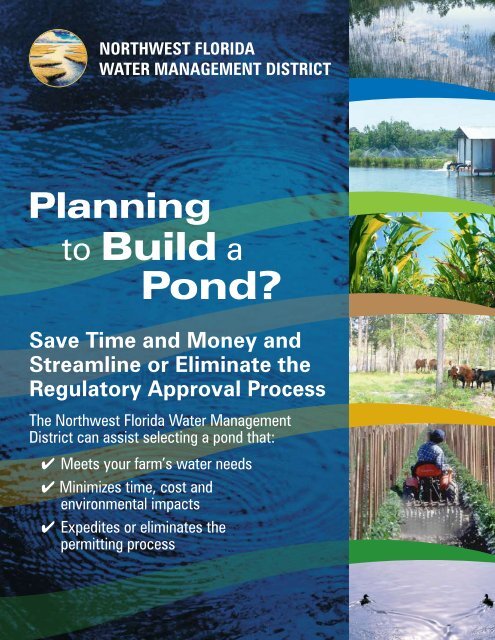Planning to Build a Pond? (Farm Pond Brochure - Northwest Florida ...
Planning to Build a Pond? (Farm Pond Brochure - Northwest Florida ...
Planning to Build a Pond? (Farm Pond Brochure - Northwest Florida ...
You also want an ePaper? Increase the reach of your titles
YUMPU automatically turns print PDFs into web optimized ePapers that Google loves.
<strong>Northwest</strong> <strong>Florida</strong><br />
water MaNageMeNt district<br />
<strong>Planning</strong><br />
<strong>to</strong> <strong>Build</strong> a<br />
<strong>Pond</strong>?<br />
Save Time and Money and<br />
Streamline or Eliminate the<br />
Regula<strong>to</strong>ry Approval Process<br />
The <strong>Northwest</strong> <strong>Florida</strong> Water Management<br />
District can assist selecting a pond that:<br />
✔ Meets your farm’s water needs<br />
✔ Minimizes time, cost and<br />
environmental impacts<br />
✔ Expedites or eliminates the<br />
permitting process
What is an Agricultural (<strong>Farm</strong>) <strong>Pond</strong>?<br />
An agricultural pond is located on a farm and used for farm purposes. It may provide<br />
water for lives<strong>to</strong>ck as well as wildlife, serve as a source of irrigation for crops and serve<br />
as a management <strong>to</strong>ol <strong>to</strong> maintain or improve water quality on the farm (<strong>Farm</strong> <strong>Pond</strong> Best<br />
Management Practices “BMPs”, <strong>Florida</strong> Department of Agriculture and Consumer Services).<br />
Agricultural ponds are of three types: upland dug pond (not located in wetlands), wetland dug<br />
pond (partially located in wetlands) or embankment pond (located directly in streams or drainage<br />
ways). Agricultural ponds must be sited, sized and designed <strong>to</strong> avoid, minimize and compensate for<br />
impacts <strong>to</strong> the natural resources.<br />
Upland Dug <strong>Pond</strong><br />
An upland dug pond is an excavated area outside<br />
of wetlands, which catches direct rainfall and/or<br />
intersects the water table.<br />
Benefits of the Upland Dug <strong>Pond</strong>:<br />
• No permit is required from the District, nor most likely<br />
from any other federal, state or local agency<br />
Wetlands<br />
Stream<br />
Upland<br />
Dug <strong>Pond</strong><br />
• Lowest cost <strong>to</strong> design, construct, maintain and operate<br />
of the pond types<br />
• Least amount of time <strong>to</strong> construct<br />
• Does not have <strong>to</strong> be designed by a licensed Professional<br />
Engineer<br />
• Minimal, if any, adverse environmental impacts<br />
• No potential for catastrophic pond failure or danger <strong>to</strong><br />
downstream life, property or infrastructure<br />
• No potential for upstream introduction of poor quality<br />
water<br />
• Complies with <strong>Florida</strong> Department of Agriculture and<br />
Consumer Services BMPs<br />
Limitations of the Upland Dug <strong>Pond</strong>:<br />
• Suitable construction sites may limit pond location<br />
and size<br />
• May require supplemental water <strong>to</strong> keep pond full
The wetland dug pond is excavated partially<br />
within a wetland area, often adjacent <strong>to</strong> a stream or<br />
water body. This pond catches direct rainfall and<br />
often intersects the water table.<br />
Benefits of the Wetland Dug <strong>Pond</strong>:<br />
• Less regula<strong>to</strong>ry burden than an embankment (in-stream)<br />
pond<br />
• Less time and cost <strong>to</strong> design, construct, maintain and<br />
operate than an embankment pond<br />
• Fewer environmental impacts than an embankment pond<br />
• No potential for catastrophic pond failure or danger <strong>to</strong><br />
downstream life, property or infrastructure<br />
Stream<br />
In-stream<br />
Embankment<br />
<strong>Pond</strong><br />
Wetlands<br />
An embankment pond is constructed by erecting<br />
an earthen dam across a stream or upland drainage<br />
way. The in-stream embankment pond obstructs<br />
and impounds stream flow causing environmental<br />
and hydrologic impacts and may create a long-term<br />
hazard <strong>to</strong> downstream properties and infrastructure.<br />
Construction of the pond often requires permits from<br />
multiple regula<strong>to</strong>ry agencies.<br />
Benefits of the Embankment <strong>Pond</strong>:<br />
• Potential increase in water availability<br />
• Can be used <strong>to</strong> control upland erosion<br />
Limitations of the In-Stream<br />
Embankment <strong>Pond</strong>:<br />
• Permit required from the District, and possibly other<br />
federal, state or local agencies<br />
Wetlands<br />
Stream<br />
Wetland Dug<br />
<strong>Pond</strong><br />
Wetland Dug <strong>Pond</strong><br />
• Minimal potential for upstream introduction of poor<br />
quality water<br />
Limitations of the Wetland Dug <strong>Pond</strong>:<br />
• Requires a permit from the District and, possibly from<br />
other federal, state or local agencies<br />
• Cost typically greater than an upland dug pond<br />
• Requires a more in-depth regula<strong>to</strong>ry evaluation than an<br />
upland pond<br />
• <strong>Pond</strong> size may be limited by environmental impact, cost<br />
and need for upland spoil disposal<br />
• Wetland dredging more difficult <strong>to</strong> perform than<br />
upland excavation<br />
Embankment <strong>Pond</strong><br />
• Most expensive pond type <strong>to</strong> design, permit, construct,<br />
maintain and operate<br />
• Must be designed by a licensed Professional Engineer<br />
registered in the State of <strong>Florida</strong><br />
• Greatest potential <strong>to</strong> have extensive hydrological and<br />
environmental impacts, including wetland destruction<br />
and downstream water quality degradation<br />
• No control over upstream introduction of poor quality<br />
water<br />
• Performance of routine maintenance is required for the<br />
life of the pond<br />
• Land use restrictions must be placed on remaining<br />
wetlands and upland buffers <strong>to</strong> compensate for<br />
environmental impacts and ensure water quality and<br />
hydrologic assurances are met<br />
• Potential for catastrophic pond failure and danger <strong>to</strong><br />
downstream life, property and infrastructure<br />
• <strong>Pond</strong> can be adversely affected by upstream and<br />
downstream land use changes, often beyond the control<br />
of pond owner
Selecting a Prospective Engineer:<br />
If the use of an embankment pond is necessary <strong>to</strong> meet the water<br />
use requirements of your farm, the services of a licensed engineer,<br />
competent in dam design and construction, will be required. The<br />
following questions may assist in selecting an engineer.<br />
• What is the estimated cost <strong>to</strong> construct the proposed pond (e.g.<br />
$30,000, $40,000, etc.)?<br />
• How many and what size dams have you engineered? What problems,<br />
if any, have those dams experienced during or after construction (e.g.,<br />
excessive seepage, poor compaction, sloughing of material, etc.)? How<br />
were the problems corrected? How long did it take <strong>to</strong> correct the<br />
problems? What additional cost was incurred by the property owner?<br />
• How will the pond you propose be sited, sized and designed <strong>to</strong> avoid,<br />
minimize and compensate for impacts <strong>to</strong> the natural resources? Will<br />
a <strong>to</strong>e drain be proposed? If not, why not? What are the operation<br />
and maintenance requirements for the proposed dam (e.g., routine<br />
mowing/tree removal)?<br />
• Who will supervise the construction of the dam? How often will<br />
they/you visit the site during construction?<br />
• If a “cored” dam is proposed, are suitable materials available locally<br />
<strong>to</strong> minimize cost? What materials will be used in the rest of the dam?<br />
Where will they be obtained?<br />
• What engineering method(s) will be used <strong>to</strong> field-verify that the correct<br />
compaction of the material is achieved? How often will compaction be<br />
verified during construction? Will there be independent testing (e.g.,<br />
a geotechnical firm)? If so, who will contract with that firm? Will I be<br />
provided a copy of all the test results?<br />
Dam Failure!<br />
Summary of the Three Types of Agricultural (<strong>Farm</strong>) <strong>Pond</strong>s<br />
Upland Dug <strong>Pond</strong><br />
• No permit required<br />
• Least cost in time and<br />
money<br />
• None <strong>to</strong> few environmental<br />
impacts<br />
• No hazard <strong>to</strong> downstream<br />
life and property<br />
Wetland Dug <strong>Pond</strong><br />
• Permit(s) are required<br />
• Less cost than an<br />
embankment pond<br />
• Minimal environmental<br />
impacts<br />
• No hazard <strong>to</strong> downstream<br />
life and property<br />
Regulation of Agricultural (<strong>Farm</strong>) <strong>Pond</strong> Construction<br />
Chapter 40A-44, <strong>Florida</strong> Administrative Code,<br />
regulates the construction, alteration, repair<br />
or abandonment of impoundments, dams or<br />
works that impound, drain or divert water for<br />
agricultural purposes. A copy of this rule, permit<br />
application and brochure can be obtained by<br />
contacting the District at the address or phone<br />
number given, or by visiting the District’s web<br />
site: www.nwfwmd.state.fl.us<br />
Embankment <strong>Pond</strong><br />
• Permit(s) and engineer are required<br />
• Most expensive pond <strong>to</strong> design, permit,<br />
construct, maintain and operate<br />
• Can result in substantial environmental<br />
impacts<br />
• Can create a long-term hazard <strong>to</strong><br />
downstream life and property<br />
<strong>Northwest</strong> <strong>Florida</strong> Water Management District<br />
152 Water Management Drive<br />
Havana, FL 32333<br />
(850) 539-5999<br />
Additional information can be obtained by contacting:<br />
U.S. Army Corps of Engineers<br />
(850) 763-0717<br />
<strong>Florida</strong> Department of Environmental Protection<br />
(850) 595-8300<br />
Contact the District <strong>to</strong> schedule a visit <strong>to</strong> your farm and we can help you obtain the<br />
water you need with less time, money, environmental impact and regulation!



